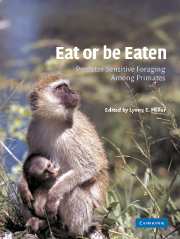1 - An introduction to predator sensitive foraging
Published online by Cambridge University Press: 10 November 2009
Summary
Studies of predator sensitive foraging in nonhuman primates are in their infancy. Predator sensitive foraging (or threat sensitive foraging, Helfman 1989) represents the strategies that animals employ to balance the need to eat against the need to avoid being eaten. For decades, these trade-offs have been investigated, in both natural and laboratory settings, by dozens of scientists working with a wide array of invertebrate, piscine, avian, and mammalian species. Ecologists working with nonprimate taxa have developed theoretical models of considerable sophistication and have generated elegant data to test those models. However, only recently have primatologists begun to turn their attention to this area of research.
The fact that studies of primates lag behind those of other taxa is due, in part, to the difficulties of observing predation on primates or even evaluating the extent to which predation imposes selective pressures on primate populations. Furthermore, field research imposes additional challenges in controlling certain variables so as to isolate and assess the effects of others. However, primate research reveals complex interactions among variables and may therefore provide a more realistic portrait of animal ecology than do oversimplified laboratory experiments. Furthermore, given the diversity in primate morphology, social structure, and habitats, this taxon represents an important opportunity to test theoretical models. It is also valuable to study the principles of predator sensitive foraging in a group of animals that rely heavily upon learning and are remarkably flexible in their behavior, as these factors may lead to further diversity and specificity in foraging strategies. Altogether, primatology has the potential to make a significant contribution to this field of research.
- Type
- Chapter
- Information
- Eat or be EatenPredator Sensitive Foraging Among Primates, pp. 1 - 18Publisher: Cambridge University PressPrint publication year: 2002
- 7
- Cited by

